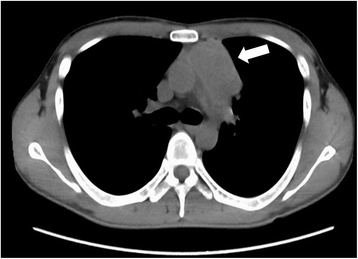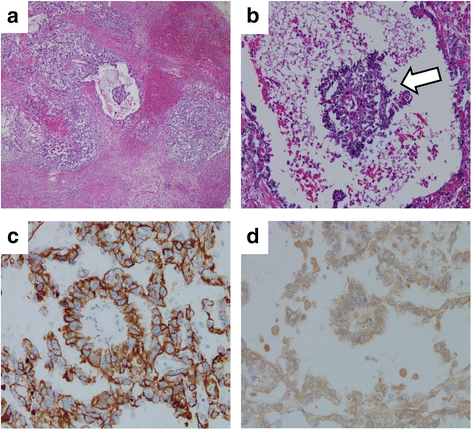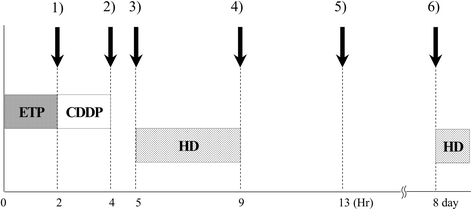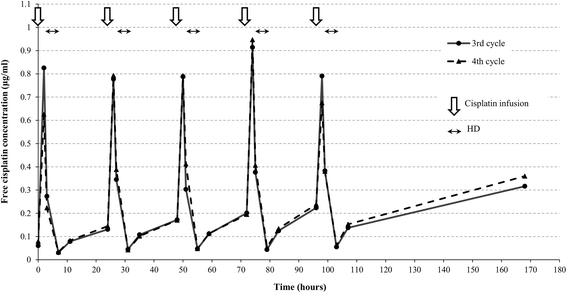Chemotherapy for primary mediastinal yolk sac tumor in a patient undergoing chronic hemodialysis: a case report
- PMID: 28202048
- PMCID: PMC5312436
- DOI: 10.1186/s13256-017-1213-7
Chemotherapy for primary mediastinal yolk sac tumor in a patient undergoing chronic hemodialysis: a case report
Abstract
Background: The safety and efficacy of chemotherapy for patients undergoing concomitant hemodialysis have not been fully established and optimal doses of anti-cancer drugs and best timing of hemodialysis remains unclear. Although chemosensitive cancers, such as germ cell tumors, treated with chemotherapy should have sufficient dose intensity maintained to achieve the desired effect, many patients with cancer undergoing hemodialysis might be under-treated because the pharmacokinetics of anti-cancer drugs in such patients remains unknown.
Case presentation: We describe a 31-year-old Japanese man with a mediastinal yolk sac tumor treated with surgery followed by five cycles of chemotherapy containing cisplatin and etoposide while concomitantly undergoing hemodialysis. The doses of these agents used in the first cycle were 50% of the standard dose of cisplatin (10 mg/m2) and 60% of the standard dose of etoposide (60 mg/m2) on days 1 through to 5; the doses were subsequently escalated to 75% with both agents. Hemodialysis was started 1 hour after infusions of these agents. Severe hematological toxicities were observed despite successful treatment. During treatment with concurrent hemodialysis, pharmacokinetic analysis of cisplatin was performed and its relationship with adverse effects was assessed. Compared with patients with normal renal function, the maximum drug concentration was higher, and concentration increased in the interval between hemodialysis and the subsequent cisplatin infusion, resulting in a higher area under the curve despite a reduction in the dose to 75% of the standard regimen.
Conclusions: Because of the altered pharmacokinetics pharmacodynamics status of patients with renal dysfunction undergoing hemodialysis, pharmacokinetics pharmacodynamics analysis is deemed to be helpful for effective and safe management of chemotherapy in patients undergoing hemodialysis.
Keywords: Cisplatin; Hemodialysis; Mediastinal yolk sac tumor; Pharmacokinetics; Renal insufficiency.
Figures




Similar articles
-
Posterior mediastinal endodermal sinus (yolk sac) tumor in a female patient.Ann Thorac Surg. 1994 Jul;58(1):244-5. doi: 10.1016/0003-4975(94)91116-9. Ann Thorac Surg. 1994. PMID: 7518667
-
Full-dose cisplatin chemotherapy combined with hemodialysis in a patient with impaired renal function and a mediastinal germ cell tumor.Anticancer Drugs. 2020 Oct;31(9):983-987. doi: 10.1097/CAD.0000000000000911. Anticancer Drugs. 2020. PMID: 32011365
-
A mediastinal germ cell tumor of yolk sac type--case report.Chirurgia (Bucur). 2010 Nov-Dec;105(6):831-4. Chirurgia (Bucur). 2010. PMID: 21351701
-
[A case of yolk sac tumor of the anterior mediastinum].Nihon Kyobu Geka Gakkai Zasshi. 1994 Aug;42(8):1203-7. Nihon Kyobu Geka Gakkai Zasshi. 1994. PMID: 7525792 Review. Japanese.
-
Anterior mediastinal nonseminomatous germ cell tumor with malignant transformation: a case report.Curr Surg. 2004 Nov-Dec;61(6):576-9. doi: 10.1016/j.cursur.2004.05.021. Curr Surg. 2004. PMID: 15590027 Review.
Cited by
-
Delivering Chemotherapy to a Metastatic Poor Risk Testicular Cancer Patient on Hemodialysis.Curr Oncol. 2022 Mar 8;29(3):1808-1812. doi: 10.3390/curroncol29030148. Curr Oncol. 2022. PMID: 35323348 Free PMC article.
-
Current Trends in the Surgical Management of Yolk Sac Tumors.Curr Oncol. 2024 Nov 6;31(11):6898-6908. doi: 10.3390/curroncol31110510. Curr Oncol. 2024. PMID: 39590141 Free PMC article. Review.
-
Yolk sac tumor of ear: a case report and literature review of the last 30 years.Int J Clin Exp Pathol. 2018 Apr 1;11(4):2142-2147. eCollection 2018. Int J Clin Exp Pathol. 2018. PMID: 31938324 Free PMC article.
References
-
- Dehner LP. Germ cell tumors of the mediastinum. Germ cell tumors of the mediastinum. Semin Diagn Pathol. 1990;7:266–84. - PubMed
-
- International Germ Cell Cancer Collaborative Group International Germ Cell Consensus Classification: a prognostic factor-based staging system for metastatic germ cell cancers. J Clin Oncol. 1997;15:594–603. - PubMed
-
- Schmoll HJ, Souchon R, Krege S, Albers P, Beyer J, Kollmannsberger C, European Germ Cell Cancer Consensus Group et al. European consensus on diagnosis and treatment of germ cell cancer: a report of the European Germ Cell Cancer Consensus Group (EGCCCG) Ann Oncol. 2004;15:1377–99. doi: 10.1093/annonc/mdh301. - DOI - PubMed
-
- Albany C, Einhorn LH. Extragonadal germ cell tumors: clinical presentation and management. Curr Opin Oncol. 2013;25:261–5. - PubMed
Publication types
MeSH terms
Substances
LinkOut - more resources
Full Text Sources
Other Literature Sources
Medical

